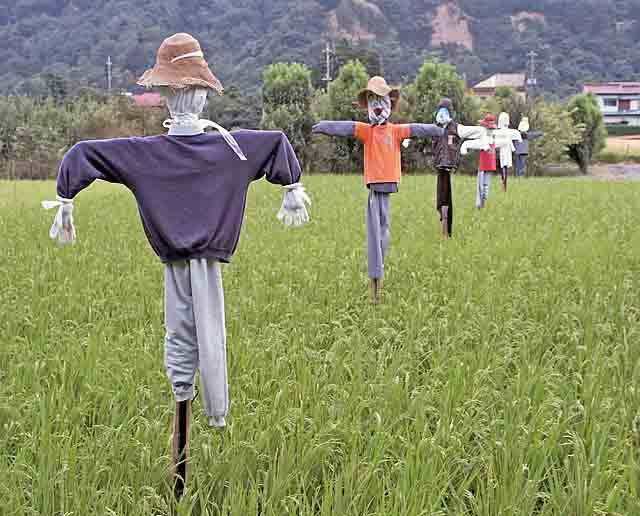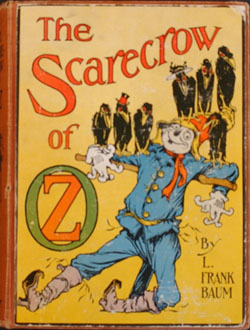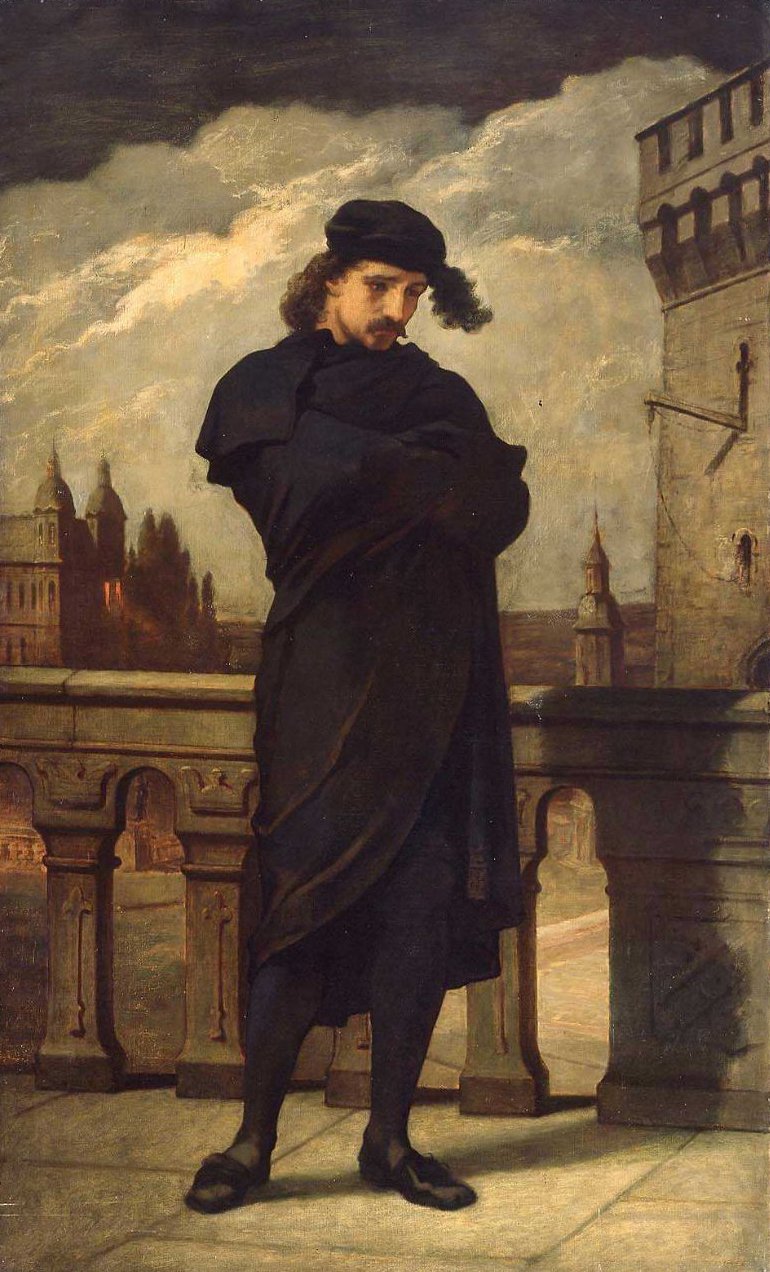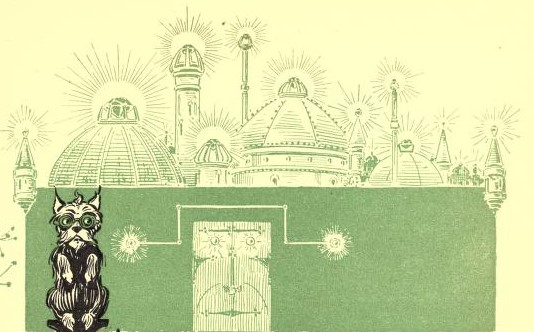|
Scarecrows
A scarecrow is a decoy or mannequin, often in the shape of a human. Humanoid scarecrows are usually dressed in old clothes and placed in open fields to discourage birds from disturbing and feeding on recently cast seed and growing crops.Lesley Brown (ed.). (2007). "Shorter Oxford English Dictionary on Historical Principles". 6th ed. Oxford: Oxford University Press. . Scarecrows are used around the world by farmers, and are a notable symbol of farms and the countryside in popular culture. Design The common form of a scarecrow is a humanoid figure dressed in old clothes and placed in open fields to discourage birds such as crows or sparrows from disturbing and feeding on recently cast seed and growing crops. Machinery such as windmills have been employed as scarecrows, but the effectiveness lessens as animals become familiar with the structures. Since the invention of the humanoid scarecrow, more effective methods have been developed. On California farmland, highly-reflective ... [...More Info...] [...Related Items...] OR: [Wikipedia] [Google] [Baidu] |
Kuebiko
is the Shinto ''kami'' ("god; deity") of folk wisdom, knowledge and agriculture, and is represented in Japanese mythology as a scarecrow who cannot walk but has comprehensive awareness. Names ''Kuebiko'' (久延毘古, literally "long stretch help old", "old long extending border", "long-reaching old helping hand"), had an alternate name of ''Yamada-no-sohodo'' (山田之曾富騰, literally, "mountain paddy-field's once wealth rise"), with ''sohodo'' transcribing '' sōdo'' ( 案山子 "scarecrow", also pronounced ''sōzu'' or ''kakashi''). The traditional etymological explanations are ''Kuebiko'' from ''kuzue-biko'' (崩え彦 "crumbling prince") and ''Yamada no Sohodo'' meaning "someone left soaking wet from standing guard over mountain rice fields", a euphemism for ''scarecrow". Mythology The (c. 712) ''Kojiki'' ("Record of Ancient Matters") has the earliest reference to Kuebiko in the myth of Ōkuninushi ("Great Land Master"). When Ōkuninushi was at Cape Miho in Izumo, ... [...More Info...] [...Related Items...] OR: [Wikipedia] [Google] [Baidu] |
Kakashi2
, is a 2001 horror film based on the Junji Ito manga of the same name. The film follows Kaoru Yoshikawa, whose search for her missing brother Tsuyoshi leads her to Kozukata, an isolated village that seems to harbor dark secrets. Plot The opening text narrates the tradition of "Kakashi", where humans would burn animal and human hairs to prevent evil spirits from entering Earth. They eventually began to burn human effigies made of straws as it also attracted the spirits of the dead so they can interact with them. Little did they know that it may bring consequences far greater than they thought. Opening in medias res, lead protagonist, Kaoru Yoshikawa (Maho Nonami) is shown screaming in front of flames, asking why it had to be done to her. In the beginning, Kaoru is a young woman who has a close relationship with her brother, Tsuyoshi; their parents had been dead since a long time ago. Unable to contact him for a week, she goes to his apartment and finds an envelope near his ... [...More Info...] [...Related Items...] OR: [Wikipedia] [Google] [Baidu] |
Airdancer
A tube man, also known as a skydancer, air dancer, inflatable man and originally called the Tall Boy, is an inflatable stick figure comprising sections of fabric tubing attached to a fan. As the fan blows air through it, the tubing moves in a dynamic dancing or flailing motion. Tube men are typically used to advertise retail business premises to passing motorists. Peter Minshall, an artist from Trinidad and Tobago, came up with the concept, and it was developed by a team that included Israeli artist Doron Gazit and Arieh Dranger, for the 1996 Summer Olympics. Minshall originally called his invention the "Tall Boy". Gazit eventually patented the concept of an inflatable, dancing human-shaped balloon, and licensed the patent to various companies that manufacture and sell the devices. A notable reference in pop culture comes from Al Harrington, a recurring character on the sitcom '' Family Guy'', who is owner, president, and CEO of "Al Harrington's Wacky Waving Inflatable Arm-Flaili ... [...More Info...] [...Related Items...] OR: [Wikipedia] [Google] [Baidu] |
His Majesty, The Scarecrow Of Oz
''His Majesty, the Scarecrow of Oz'' is a 1914 American silent fantasy adventure film directed by J. Farrell MacDonald, and written and produced by L. Frank Baum. It stars Violet MacMillan, Frank Moore, Vivian Reed, Todd Wright, Pierre Couderc, Raymond Russell, and Fred Woodward. The film had a troubled distribution history; it opened on September 28, 1914, to little success, though it was received as well above average fare by critics of the time.See reviews collected from various trade papers in ''The Baum Bugle'' Winter 2005 Early in 1915, it was reissued under the title ''The New Wizard of Oz'' and was slightly more successful. The film is loosely based on Baum's 1900 book ''The Wonderful Wizard of Oz'', but in the screenplay, Baum introduced many new characters and a large new story that later became the basis for the 1915 book ''The Scarecrow of Oz''. Similar to ''The Wonderful Wizard of Oz'', the Scarecrow's origin is revealed, although his life is now attributed to " ... [...More Info...] [...Related Items...] OR: [Wikipedia] [Google] [Baidu] |
Brain
A brain is an organ that serves as the center of the nervous system in all vertebrate and most invertebrate animals. It is located in the head, usually close to the sensory organs for senses such as vision. It is the most complex organ in a vertebrate's body. In a human, the cerebral cortex contains approximately 14–16 billion neurons, and the estimated number of neurons in the cerebellum is 55–70 billion. Each neuron is connected by synapses to several thousand other neurons. These neurons typically communicate with one another by means of long fibers called axons, which carry trains of signal pulses called action potentials to distant parts of the brain or body targeting specific recipient cells. Physiologically, brains exert centralized control over a body's other organs. They act on the rest of the body both by generating patterns of muscle activity and by driving the secretion of chemicals called hormones. This centralized control allows rapid and coordinated respon ... [...More Info...] [...Related Items...] OR: [Wikipedia] [Google] [Baidu] |
Scarecrow (Oz)
The Scarecrow is a character in the fictional Land of Oz created by American author L. Frank Baum and illustrator W.W. Denslow. In his first appearance, the Scarecrow reveals that he lacks a brain and desires above all else to have one. In reality, he is only two days old and merely naïve. Throughout the course of the novel, he proves to have the brains he seeks and is later recognized as "the wisest man in all of Oz," although he continues to credit the Wizard for them. He is, however, wise enough to know his own limitations and all too happy to hand the rulership of Oz, passed to him by the Wizard, to Princess Ozma, and become one of her trusted advisors, though he typically spends more time having fun than advising. Character biography In ''The Wonderful Wizard of Oz'' In Baum's classic 1900 novel ''The Wonderful Wizard of Oz'', the living scarecrow encounters Dorothy Gale in a field in the Munchkin Country while she is on her way to the Emerald City. He tells her about his ... [...More Info...] [...Related Items...] OR: [Wikipedia] [Google] [Baidu] |
Protagonist
A protagonist () is the main character of a story. The protagonist makes key decisions that affect the plot, primarily influencing the story and propelling it forward, and is often the character who faces the most significant obstacles. If a story contains a subplot, or is a narrative made up of several stories, then each subplot may have its own protagonist. The protagonist is the character whose fate is most closely followed by the reader or audience, and who is opposed by the antagonist. The antagonist provides obstacles and complications and creates conflicts that test the protagonist, revealing the strengths and weaknesses of the protagonist's character, and having the protagonist develop as a result. Etymology The term ''protagonist'' comes , combined of (, 'first') and (, 'actor, competitor'), which stems from (, 'contest') via (, 'I contend for a prize'). Ancient Greece The earliest known examples of a protagonist are found in Ancient Greece. At first, dramatic pe ... [...More Info...] [...Related Items...] OR: [Wikipedia] [Google] [Baidu] |
The Wonderful Wizard Of Oz
''The Wonderful Wizard of Oz'' is a children's novel written by author L. Frank Baum and illustrated by W. W. Denslow. It is the first novel in the Oz series of books. A Kansas farm girl named Dorothy ends up in the magical Land of Oz after she and her pet dog Toto are swept away from their home by a tornado. Upon her arrival in Oz, she learns she cannot return home until she has destroyed the Wicked Witch of the West. The book was first published in the United States in May 1900 by the George M. Hill Company. In January 1901, the publishing company completed printing the first edition, a total of 10,000 copies, which quickly sold out. It had sold three million copies by the time it entered the public domain in 1956. It was often reprinted under the title ''The Wizard of Oz'', which is the title of the successful 1902 Broadway musical adaptation as well as the classic 1939 live-action film. The ground-breaking success of both the original 1900 novel and the 1902 Broadway ... [...More Info...] [...Related Items...] OR: [Wikipedia] [Google] [Baidu] |
The Scarecrow (play)
''The Scarecrow'' is a play written by Percy MacKaye in 1908, and first presented on Broadway in 1911. It is based on Nathaniel Hawthorne's short story, "Feathertop", but greatly expands upon the tale. Mackaye himself stated that he hoped that the play would not be taken as a dramatization of "Feathertop", since the intentions of the two works are so different: "The scarecrow Feathertop is ridiculous, as the emblem of a superficial fop; the scarecrow Ravensbane is pitiful, as the emblem of human bathos." Productions Frank Reicher, known to modern audiences for playing the ship's captain in the original ''King Kong'' and its sequel ''Son of Kong'', starred in the title role in the original 1911 Broadway production. The play had what would now be considered an extremely short run in New York (23 performances). In 1923 it was filmed as a silent movie, ''Puritan Passions'', starring Mary Astor. The play was revived twice in New York (most recently in 2005), has been made into an opera, ... [...More Info...] [...Related Items...] OR: [Wikipedia] [Google] [Baidu] |
Percy MacKaye
Percy MacKaye (1875–1956) was an American dramatist and poet. Biography MacKaye was born in New York City into a theatrical family. His father, Steele MacKaye, was a popular actor, playwright, and producer, while his mother, Mary, wrote a dramatization of Pride and Prejudice, first produced in 1910. His brother James MacKaye was a philosopher, while brother Benton MacKaye was a forester and conservationist. His sister, Hazel MacKaye, became a women's suffrage leader and pageant director. After graduating from Harvard in 1897, he traveled in Europe for three years, residing in Rome, Switzerland and London, studying at the University of Leipzig in 1899–1900. He returned to New York City to teach at a private school until 1904, when he joined a colony of artists and writers in Cornish, New Hampshire, and devoted himself entirely to dramatic work. He wrote the plays ''The Canterbury Pilgrims'' in 1903, '' Sappho and Phaon'' in 1907, ''Jeanne D'Arc'' in 1907, '' The Scarecro ... [...More Info...] [...Related Items...] OR: [Wikipedia] [Google] [Baidu] |
Salem, Massachusetts
Salem ( ) is a historic coastal city in Essex County, Massachusetts, located on the North Shore of Greater Boston. Continuous settlement by Europeans began in 1626 with English colonists. Salem would become one of the most significant seaports trading commodities in early American history. It is a suburb of Boston. Today Salem is a residential and tourist area that is home to the House of Seven Gables, Salem State University, Pioneer Village, the Salem Maritime National Historic Site, Salem Willows Park, and the Peabody Essex Museum. It features historic residential neighborhoods in the Federal Street District and the Charter Street Historic District.Peabody Essex announces $650 million campaign WickedLocal.com, November 14, 2011 [...More Info...] [...Related Items...] OR: [Wikipedia] [Google] [Baidu] |
Feathertop
"Feathertop" is a short story by Nathaniel Hawthorne, first published in 1852. The moral tale uses a metaphoric scarecrow named Feathertop and its adventure to offer the reader a conclusive lesson about human character. It has since been used and adapted in several other media forms, such as opera and theatre. Plot In seventeenth century New England, the witch Mother Rigby builds a scarecrow to protect her garden. She is so taken with her own handiwork that she whimsically decides to bring the scarecrow to life and send it into town to woo Polly Gookin, the daughter of Judge Gookin, with whom Mother Rigby had unspecified prior dealings. Once the stuffed man does come alive, Mother Rigby gives him the appearance of a normal human being and provides a pipe, on which the scarecrow must puff to keep himself alive. Judge Gookin meets the scarecrow, whom Mother Rigby has named Feathertop. Feathertop is introduced to Polly, and the two begin to fall in love. But when Polly and Featherto ... [...More Info...] [...Related Items...] OR: [Wikipedia] [Google] [Baidu] |







